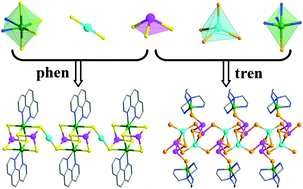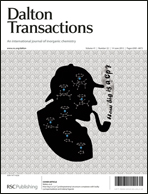Four organic-decorated quaternary TM–Hg–Sb–Q compounds, namely, [Mn(phen)]2HgSb2S6 (phen = 1,10-phenanthroline) (1) and isomorphic [TM(tren)]HgSb2Se5 (TM = Mn (2), Fe (3), Co (4); tren = tris(2-aminoethyl)amine) have been solvothermally prepared, and structurally characterized by single crystal X-ray diffraction analyses. 1 and 2 (3, 4) feature distinct one-dimensional neutral infinite ribbon-like structures constructed by the combination of Sb3+, Hg2+ and TM2+, the latter two of which adopt different coordination modes. In compound 1, organic-decorated {[Mn(phen)]2Sb2S6} clusters assembled by {MnS4N2} octhedra and {SbS3} pyramids are bridged by the {HgS2} groups in a linear fashion. Differently, the {SbSe3} pyramids, {HgSe4} tetrahedra and {TMSeN4} trigonal-bipyramids in 2 (3, 4) are combined to form novel {[TM(tren)]2Hg2Sb4Se12} clusters, which are interconnected to form {[TM(tren)]HgSb2Se5}n ribbons. The results of optical diffuse-reflectance measurements and band structure calculations based on DFT methods indicate that 1 and 2 (3, 4) are indirect and direct semiconductors, respectively. Photocatalytic experiments have shown the ability of 2 in photodegradation of Rhodamine B (RhB).


 Please wait while we load your content...
Please wait while we load your content...